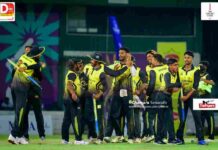To score a maiden Test hundred on your 20th birthday by hooking the world’s greatest fast bowler in front of your parents is simply fairytale stuff.
Those are things that you dream of. Well, not for Aravinda de Silva. On a day like this, that’s exactly what he did in 1985 in Faisalabad as he took on Imran Khan to reach three figures for the first time in his career in front of Mr. and Mrs. Sam and Rani de Silva. He is 52 today.
A nation loves its first heroes. That’s why even after Kumar Sangakkara (12,400 runs and 38 hundreds) scoring double the amount of Test runs and twice as many Test centuries than Aravinda (6361 runs and 20 hundreds) the latter is hailed as the greatest batsman produced by the country.
His batting was full of positivity. First ball he faced or one away from a hundred, if the ball was meant to put away, Aravinda did it with ease and style. He preaches the same mantra to those who come in search of his wisdom. The only problem is that the lesser mortals are unable to practice what he preaches.
සංගා, මහේල, අරවින්ද අලූත් සූත්රයක් සමඟින් නැවතත් පිටියට
සංගා, මහේල, අරවින්ද අලූත් සූත්රයක් සමඟින් නැවතත් පිටියට…
Since retirement, he has carried on the same positivity as a selector and administrator. Many are the young players who have benefited by his inputs to their game.
His Test debut came in Sri Lanka’s first ever Test match in England. That too at Lord’s. Having debuted as a 19-year-old, he retired as the finest batsman produced by the country after 93 Tests spanning over 18 years.
Aravinda’s 167 at The Gabba against a strong Australian pace attack in 1989 and a career best 267 at Wellington against New Zealand in 1991 were two of his best knocks. But he really came to make an impact after his stint with English county Kent in 1995. The hundred he scored in the Benson & Hedges Cup final at Lord’s nearly won them the championship against a strong Lancashire attacked spearheaded by Wasim Akram. He was named Man of the Match in a losing cause.
The number are just stunning. Prior to his Kent stint, Aravinda averaged just 37. After Kent his average rose to 50.
Straight after the county stint, Aravinda flew to Faisalabad from London. By the time he joined the squad, Sri Lanka had already lost the first Test heavily. A sensational hundred in the second Test helped Sri Lanka to square the series and the tourists went onto complete a 2-1 series win by winning the final game in Sialkot.
The double hundred Sanath Jayasuriya scored and Muttiah Muralitharan’s match bag of 17 wickets are often highlighted when discussing Sri Lanka’s maiden Test win in England in 1998. But Aravinda’s 152 was equally important.
Sir Garry Sobers in early 1990s was asked as to who would break his World Record for most runs in an innings. He singled out four players – Mark Waugh, Sachin Tendulkar, Brian Lara and Aravinda. As Sri Lanka’s coach in the early 1980s, Sir Garry had seen plenty of Aravinda.
It’s a pity that during Aravinda’s best days, there was little international cricket in Sri Lankan for five years. Between the age of 22 and 27, he didn’t play a single Test match at home and had he done so, he would have finished with a far higher aggregate than his eventual 6361 runs.
හොඳම ශ්රී ලාංකික පිතිකරුවන් කවුරුන් ද?
ශ්රී ලංකා ටෙස්ට් ක්රිකට් ඉතිහාසය ඇරඹෙන්නේ 1982 වර්ෂයෙනි….
Then again for two more years he lost out on quite a bit of cricket as the selectors adopted a youth policy from 2001 to 2002. Once Michael Tissera was appointed as Chairman of Selectors, he brought Aravinda back to the side he went onto play the 2003 World Cup.
During that World Cup, his brutal attack on Brett Lee at the Centurion during a majestic 92 was a treat to watch as he flicked successive sixes off the fastest bowler in the world bisecting deep fine-leg and deep square-leg fielders. He went onto become the first Sri Lankan to score 1000 runs in World Cups having featured in five tournaments from 1987 to 2003.
In domestic cricket, he lacked motivation if the competition wasn’t up to his standard. As revealed by rival captain Arjuna Ranatunga, the best ploy adopted by SSC to dismiss him was to bring on a part-time bowler as soon as he came to bat. Soon he would get bored and get out. However, if you bounced at him that was the end of the story! The plight of poor Ruchira Perera during a Bloomfield versus NCC encounter at Reid Avenue is all too well known in cricket circles.
The partnership between Kumar Sangakkara and Aravinda as captain and Chairman of Selectors from 2010 to 2011 was one of the most successful ones in recent history. Both intellectuals of the game, they used to argue on strategy for hours and that brought the best out of the team.
It was a tedious task as there were constant interferences, but to his credit, Aravinda did a stellar job and quit as Chairman of Selectors after Sri Lanka’s loss in the final to India.
Sangakkara the batsman too benefited by Aravinda’s mastery. His first tour to England in 2002 was Aravinda’s last away Test series. Sangakkara had trouble driving straight and a slight adjustment suggested by Aravinda on the positioning of his thumb and forefinger saw Sangakkara driving neatly past mid-on and mid-off.
Angelo Mathews was another player to benefit by chatting to Aravinda. During Sri Lanka’s tour of England in 2014, he picked Aravinda’s brains on countering early summer English conditions on his first Test tour to the country.
Mathews went onto make a hundred at Lord’s in his first Test at the Home of Cricket and followed it up with a match winning 160 in the second Test at Leeds and was named Player of the Series.
There are some well kept secrets about his success during the 1996 World Cup triumph. Apparently, he had three different grips and changed them according to the bowlers. He turned vegetarian six months prior to the World Cup in an effort to lose weight. He also had used a heavier bat during that successful campaign as the weight of the bat denied him the chance of hooking, his Achilles’ heel.
ThePapare.com wishes him a very happy birthday. Ad multos annos.

















